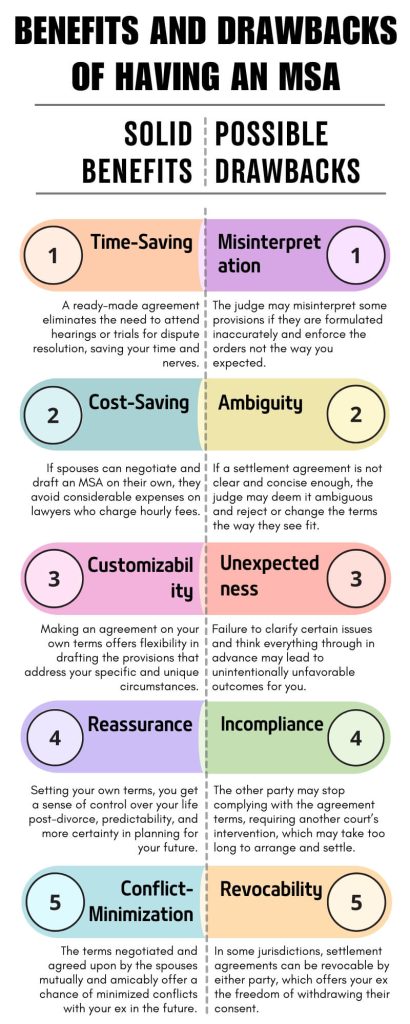Most divorce-related disputes can be resolved by a coupe amicably without third-party involvement. Moreover, courts in many states usually encourage divorcees to set their own terms by entering into a marriage settlement agreement before the final hearing on the case. Such an option is mutually beneficial since it saves time, money, and nerve for a couple and unburdens the court’s caseload.
While such documents may come under diverse names, of which Marital Settlement Agreement (MSA) is the most common, and vary in structure and form in different states, their main purpose and function are the same. In this article, we answer the most frequent questions to explain the key aspects of this document so you can decide if you need one and how to go about it.
MSA in Divorce: Meaning
The primary meaning of a standard divorce agreement in any state is to settle some or all the disputes related to marriage termination by reaching a consensus between the parties without the court’s interference.
MSA may be generally described as a comprehensive written contract that outlines the terms the court should define in a divorce case. Depending on the state, it may be called Marital Settlement Agreement, Separation Agreement, Divorce Settlement Agreement, Mediated Agreement, Property Settlement Agreement, Stipulation of Settlement, etc. Yet, any of these titles showcases the document’s main purpose, which is to lay out both divorcing parties’ rights, obligations, and responsibilities concerning their property, children, and relations after their marriage ends.
Similarly, each state, county, or even court may have its own requirements concerning the form and structure of an MSA. Some have a standard form that must be filled in; others allow divorcees to draft it arbitrarily while following the legal document norms. Nevertheless, whatever the situation in your specific court, the agreement may cover everything a couple owns or owes, ranging from child care after divorce to financial settlements, property division, etc.
How Do Divorce Settlements Work?

Once both spouses sign a divorce settlement agreement, the document becomes legally binding, obliging them to abide by the terms outlined in it. That is why it is highly important to thoroughly think through each matter and the possible outcomes to make the most advantageous decisions.
In some states, an MSA is one of the official forms that must be filed with the court together with other mandatory documents. Thus, it must be accurately filled out, signed by both spouses, and properly notarized. In others, it is just a supplement to the divorce paperwork package drafted by a couple and presented for the judge’s consideration. Sometimes, it may even be oral, read into the court’s record during a hearing.
Whatever your state’s laws concerning a settlement agreement are, the court is most likely to approve it if it is not unfair or illegal, does not violate public policies, was not signed as a result of fraud, duress, or coercion, and contains reasonable and fair terms that follow the current legislature and meet the child’s best interests. Once the judge approves and signs the document, the provisions outlined in it are incorporated into the divorce decree to become the final court order. As a contract, MSA is governed by the principles of general contract law.
How Long Do I Have to Pay Divorce Settlement?
The duration of any payments is defined by the terms specified in a divorce settlement agreement.
Generally, while drafting an MSA, spouses are supposed to reach agreements concerning all the accompanying financial issues, ranging from the amounts and duration of child and spousal support to the terms of debt payouts, compensations for the sold marital property, and even attorney’s fees. Therefore, a couple should determine it on their own at the negotiation stage and include it in the agreement. If the judge finds any of these terms unreasonable or against the set standards, they may modify them before entering into the final order.
How to Write a Divorce Agreement?

You may prepare a divorce settlement agreement yourself or get legal help from an experienced attorney. Yet, certain aspects must be considered. Here is a brief step-by-step guide:
- Find out your local regulations concerning settlement agreements. Is there an official court form to fill out? Does your state, county, or court allow couples to draft it arbitrarily? Are there any specific requirements as for the terminology or formulation of terms?
- Get an official form or template of an MSA used in your location. You may turn to local libraries or your county court’s clerk or visit your court’s online self-help center.
- Negotiate the terms you want to settle in the agreement with your spouse.
- Fill in the form you obtained or write your own contract. Specify the basic details, including both parties’ names, birthdates, and current addresses, marriage date and location, separation date, divorce grounds, details about minor children, etc. Outline the terms concerning property, assets, debts, children, financial support, etc.
- Review the agreement carefully, paying attention to each detail. Double-check that everything is specified exactly the way you have agreed upon with your spouse.
- Proofread the document and ensure that it contains no mistakes or typos, leaving no chance for misconceptions, and that it would be clear to anyone who will read it.
- Sign and notarize the agreement if your state divorce laws require this.
Spouses may draft an MSA on their own if they have a reliable template and are attentive to the details. Some couples may be unsure if they can do it properly and choose to hire attorneys who can provide them with legal advice on things to consider in a divorce agreement and its appropriate presentation. However, considering the current layers’ hourly rates, such assistance may be quite costly. To get expert help with preparing the document while saving money, many spouses use online divorce paperwork preparation services like ours.

What to Ask for in a Divorce Settlement?
A divorce settlement agreement normally contains the terms of all the matters that must be addressed in a marriage dissolution case. They may include but are not limited to:
- Child care, custody, and support;
- Placement and relocation considerations;
- Name change;
- Post-divorce communication and interactions between the parties and their children;
- Alimony;
- Property and debt division;
- Marital house arrangements;
- Pension and insurance plans, retirement accounts, and other financial matters;
- Testamentary provisions;
- Enforcement mechanisms in case of breaching the terms;
- Modification and termination provisions;
- Taxes;
- Attorney’s fees.
It’s totally up to the divorcing couple to decide which provisions to include in their settlement agreement. Moreover, spouses can set specific terms related to their unique circumstances and needs, even if they do not follow a conventional way of resolution. For example, if property settlements in a divorce are governed by equitable distribution principles as per the state laws, but a couple wants to adjust the status of their assets and divide them in their own way, they may specify corresponding terms in their marital settlement agreement.
Yet, remember that an MSA will affect many aspects of your after-divorce life, specifying who gets what and how things will be. Therefore, be reasonable and extremely accurate in your decisions.
What Happens After You Agree to a Settlement?
After you and your spouse have agreed to a settlement and verified it in a written contract, you must follow specific regulations. In some states, such official documents must be signed by both parties before a notary public and filed with the court at a certain fee. In others, a plaintiff must only present it to the judge at a hearing.
If the judge approves and signs your MSA, its terms will be incorporated in a final judgment that finalizes your divorce and will become enforceable right away. An uncontested divorce, when both parties agree on all the terms, saves a lot of time and money while also minimizing the stress associated with the process.
When Does a Settlement Agreement Become Binding?
Courts often recognize that an MSA becomes legally binding once both spouses sign it. Nevertheless, it may depend on the language used in your amicable divorce agreement, specifically if it contains any provisions about its effective date. For example, you or your attorney may point out that the contract becomes enforceable on the signing date or only upon incorporating it into the final divorce judgment.
Divorce Settlement Agreement Example
If state divorce laws allow or even require spouses to enter into a written contract, the court usually has at least a sample of an acceptable divorce settlement agreement or an official form that must be completed and filed with other papers. You may turn to your local court in person or browse its official website to request a template or a blank form.
See an example of a typical divorce settlement agreement that can be followed if your local law does not have any specific and strict requirements concerning its form and structure.
Can You Change Divorce Agreement After Signing?

In almost all states and cases, a divorce agreement can be amended after signing either if both parties consent or if a substantial change in circumstances on either side occurs. Whatever the case is, the requesting party should file a motion or petition for modification with the court so that the judge can review the pleading and make changes to the final order. Mind that you must have a good reason for modifications and provide solid proof for approval and a positive outcome.
Nevertheless, there can be exceptions if the state’s family law and property settlement principles do not provide for changes in some specific terms. It is better to consult with the local court’s clerk on the possible options.
Does a Marital Settlement Agreement Need to Be Notarized?

Depending on the specific state laws, divorce agreement papers must or should not be notarized. Before arranging any settlements and completing any forms, research and get to know divorce laws in your state as well as specific county court requirements.


